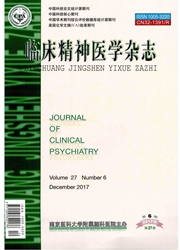

 中文摘要:
中文摘要:
目的:探讨伴有迟发性运动障碍(TD)的精神分裂症患者血清铁调素(Hep)、铁蛋白(Fn)水平,以及铁代谢状况与TD的关系。方法:采用酶免疫法及化学发光法测定30例伴TD的精神分裂症患者(TD组)、41例不伴TD的精神分裂症患者(非TD组)及41名正常人(正常对照组)血清Hep、Fn水平;用异常不自主运动量表(AIMS)评估患者TD的严重程度及其与血清Hep、Fn水平的相关性。结果:TD组血清Hep水平低于非TD组及正常对照组(Z=-2.99,Z=-3.62;P均〈0.01),非TD组与正常对照组之间Hep水平差异无统计学意义(Z=1.22,P〉0.05);TD组血清Fn水平高于非TD组及正常对照组(Z=2.00,Z=2.39;P均〈0.05),非TD组与正常对照组之间Fn水平差异无统计学意义(Z=-0.70,P〉0.05)。TD组血清Hep水平与Fn水平呈负相关(r=-0.396,P〈0.05),AIMS评分与血清Hep及Fn水平无相关性(r=-0.052,r=0.14;P均〉0.05)。结论:TD患者存在铁代谢蛋白异常,铁代谢障碍可能参与了TD的病理生理过程。
 英文摘要:
英文摘要:
Objective: To explore the serum levels of hepcidin ( Hep), ferritin ( Fn ) in schizophrenics with tardive dyskinesia(TD) as well as the relationship between iron metabolic status and TD. Method:Serum levels of Hep and Fn in 30 schizophrenics with TD (TD group ), 41 schizophrenics without TD (non-TD group) and 41 normal subjects(normal control group) were measured by enzyme immunoassay and chemilumi- nescence, respectively. Severity of TD was assessed with the abnormal involuntary movement scale (AIMS). Cor- relation of score of AIMS and serum level of Hep, Fn were analyzed. Results: Serum level of Hep in TD group was significantly lower than that in non-TD group and normal control group ( Z = - 2. 99, Z = - 3.62, all P 〈 0.01 ), while no difference was shown between non-TD group and normal control group ( Z = 1.22, P 〉 0.05 ). Serum level of Fn in TD group was higher than that in non-TD group and normal control group ( Z = 2. 00, Z = 2.39, all P 〈 0. 05 ), there was also no significant difference in serum level of Fn between non-TD group and normal control group( Z = - 0. 70, P 〉 0.05 ). In TD group, serum level of Hep was negatively correlated with serum level of Fn(r = -0. 396,P 〈0.05) ,no correlation existed between score of AIMS and serum level of Hep or Fn ( r = - 0. 052, r = 0.14 ; all P 〉 0.05 ). Conclusion: TD patients have abnormal iron metabolic protein. Iron metabolic disorder may he involved in the pathophysiologieal process of TD.
 同期刊论文项目
同期刊论文项目
 同项目期刊论文
同项目期刊论文
 Association Between BDNF Val66Met Polymorphism and Cognitive Performance in Antipsychotic-Na?ve Pati
Association Between BDNF Val66Met Polymorphism and Cognitive Performance in Antipsychotic-Na?ve Pati Exploring the pathogenetic association between schizophrenia and type 2 diabetes mellitus diseases b
Exploring the pathogenetic association between schizophrenia and type 2 diabetes mellitus diseases b 期刊信息
期刊信息
